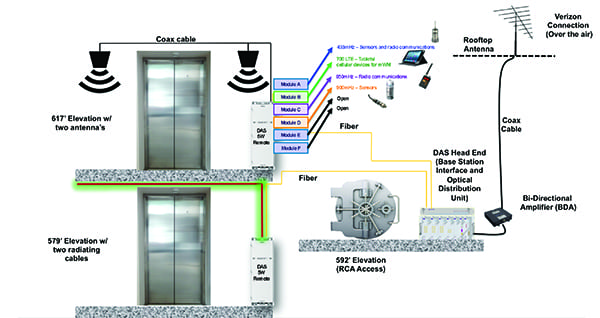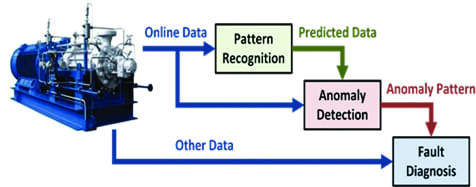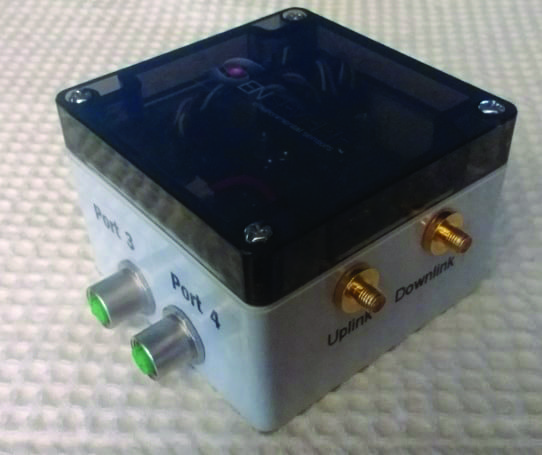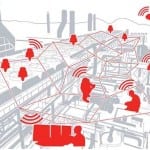The Electric Power Research Institute’s full spectrum of online monitoring-related research offers nuclear power plant operators guidance for monitoring program implementation. The research results are used to inform maintenance tasks and ultimately automate the plant to optimize performance.
The Electric Power Research Institute (EPRI) continues to increase its online monitoring and automation research and development (R&D) portfolio for nuclear plants with a goal to reduce operations and maintenance (O&M) costs. With four technical reports already published and many more in the works, EPRI’s efforts span a full spectrum of online monitoring (OLM) and automation-related topics.
“We have several years of experience researching OLM systems used in the fossil power generation industry,” said Christopher Kerr, principal technical leader at EPRI. “Based on the success of monitoring and diagnostic centers at fossil plants, we started looking at how to effectively translate, and improve, this technology for the nuclear power industry.”
A gap analysis comparing the current state to the desired state of OLM implementation at nuclear facilities revealed significant savings across a variety of areas, including preventive maintenance costs.
“A major change in our R&D is to focus more on using OLM to reduce O&M costs, specifically eliminating manual preventive maintenance tasks,” Kerr added.
Guidance for the Implementation of an OLM Program
While a few nuclear operators have already implemented OLM programs, others have been more hesitant. To help, EPRI’s Online Monitoring Guide for Equipment Diagnostics and Reliability-Nuclear Generation (3002010577) details the systematic development and implementation of an effective plant-monitoring program. Published in May 2017, the report covers how to define the monitoring program’s goals, project scope, implementation plans, and more.
“To make sure the process is scalable, we considered different business cases in the report—because a model that might work for a fleet of plants won’t necessarily translate to a smaller scale single nuclear unit at a company that also has fossil assets,” Kerr explained.
Concurrently, EPRI published Developing a Technical Basis for Using On-Line Equipment Condition Monitoring to Reduce Time-Based Preventive and Predictive Maintenance (3002010579). This report identifies plant equipment to be monitored based on historical preventive maintenance costs, and determines the parameters to be monitored based on equipment failure mechanisms.
“For instance, instead of performing time-based maintenance, you can monitor the vibration of a pump to warn of bearing failure before it occurs,” Kerr said.
This evaluation can significantly cut O&M costs by providing support for extending or eliminating preventive maintenance tasks, while at the same time improving reliability.
“Nuclear plants have excellent equipment reliability with very few failures, and we want to improve that while cutting costs,” Kerr noted.
Obtaining the Data: Getting the Right Sensors in the Right Place
To effectively monitor equipment health, the right sensors need to be installed in the right locations. Because installation of standard wired sensors can be very expensive in a nuclear power plant, EPRI is supporting the increased use of wireless sensors (Figure 1).
According to Stephen Lopez, senior technical leader at EPRI, a utility that recently decided to add a wired vibration monitoring system discovered that the cost would be about 10 times that of a similar job at a fossil plant.
“While the work isn’t physically much different, the modification process is considerably more demanding in the nuclear industry,” Lopez explained. “That means one of the biggest benefits we can provide for the industry is guidance on the effective use of wireless sensor and networking technology.” This research will help operators acquire and effectively operate monitoring sensors inside nuclear power plants.
EPRI’s Sensor Survey and General Specification (due to be released in the first quarter 2018) contains an assortment of useful information to help nuclear utilities identify sensor requirements, and obtain and implement these systems in a variety of monitoring applications.
An electromagnetic compatibility evaluation was also performed to assess wireless sensor implementation and evaluate a sample set of sensors against the existing industry electromagnetic compatibility guidance. EPRI’s research incorporates findings into a general specification that provides a starting point for a successful system implementation.
Transporting Data Via Distributed Antenna Systems (DAS)
Wireless sensors need a reliable method to transport data. Many nuclear plants have Wi-Fi available, but the remote location of some equipment and structural components of a plant can make it difficult to get radio frequency (RF) signals where they are needed. These issues led EPRI to take an in-depth look at a distributed antenna system (DAS) to effectively support the industry’s current and future technology needs.
Published in March 2017, EPRI’s Use of LTE Cellular Network and Distributed Antenna Systems to Improve Connectivity and Increase Data Transfer: A Plant Monitoring Initiative (3002009128) discusses how a DAS can be a credible wireless data transmission option inside the power block (Figure 2). DAS technology can be coupled with antennas and “leaky cable” radiating cables with a proven record in other industries. The report includes lessons learned from two pilot demonstrations conducted on units at a retired nuclear power plant.
 |
| 2. Distributed antenna system (DAS). A DAS can be a credible wireless data transmission option for nuclear power plants. This image shows an example of how a system could be connected. Courtesy: EPRI |
DAS flexibility allows two-way radios, cellular devices (including tablets), wireless sensors, and other wireless devices to operate from one platform, potentially saving plants millions of dollars. Because a DAS is both frequency and wireless protocol agnostic, a modular design allows for a platform that can grow with future needs with minimum hardware enhancements.
“Most people associate DAS with cellular phones, but this is only one piece of the puzzle,” said Nick Camilli, senior technical leader at EPRI. “A DAS can support licensed and unlicensed frequency spectrum, which is a game changer for the industry.”
Initial tests conducted on retired units show promise for addressing coverage challenges. DAS testing performed at both 730 MHz and 2.13 GHz showed that the lower frequency provided about 80% coverage at the target threshold of–95 decibel-milliwatt (dBm) or higher—about twice the coverage of the higher frequency.
Several utilities are installing DAS now for plant monitoring and automation products. To make this process even more efficient, EPRI is developing a nuclear plant common design package for installing such a system. This common design package will be completed in early 2018.
Whether wired or wireless, any data transport design must address related cybersecurity concerns. EPRI’s November 2016 Cyber Security: Isolation for Maintenance, Monitoring, and Diagnostic Applications in Nuclear Power Facilities (3002008206) report presents several segregation and segmentation concepts and techniques that can be used by site and fleet cybersecurity, engineering, and information technology support personnel to avoid unnecessary cybersecurity burden.
Using the Data: Improved Diagnostics and Prognostics with Analytics
The final piece of the OLM puzzle—and probably the most talked about—is how to harness the potential of data analytics to lower O&M costs. Several teams at EPRI have been working to develop and assess data analytics tools that can accurately diagnose plant performance across a spectrum of performance areas, including passive and safety-related equipment, to support effective decision making by plant staff.
“EPRI is making a significant commitment to promote research and develop tools related to data analytics,” said Rob Austin, instrumentation and control (I&C) senior program manager at EPRI.
The nuclear industry has been successfully using advanced pattern recognition systems for a while to look for trends or deviations from normal equipment performance and provide associated alerts to the engineering staff monitoring the system data (Figure 3). According to Austin, EPRI wants to take these early warning systems to the next level by providing improved parameter-based diagnostics and prognostics capability. Multiple vendors are producing data analytics tools based on similar concepts.
 |
| 3. What can the data tell you? Online data goes into an advanced pattern recognition system that shows deviations from predictions and recommends a fault diagnosis. Courtesy: EPRI |
“If vibration goes up on a pump, we need software that can note whether the temperature went up on a bearing as well,” Austin explained. “Did it uncover flow variations in the system? Can it identify a bearing that might be starting to wear and predict when it should be replaced? These are the kinds of questions that our smart systems should be able to answer to provide engineers with a bigger picture that supports condition-based maintenance and reduces the chances of catastrophic equipment failure in the plant.”
EPRI’s I&C lab is conducting performance testing of several data analytics tools, using actual plant information data including equipment failures.
“We are developing evaluation techniques to determine which data analytics tools are the best for our purposes,” said Austin.
Taking Advantage of Interfacing Projects
Throughout EPRI, teams are working together to share information on a variety of related OLM projects, including:
■ Smart ChemWorks. Sophisticated “fingerprint” pattern matching and statistical methods are being used for real-time chemistry monitoring and advice.
■ Remote Radiation Monitoring. The use of radiation remote monitoring technologies is being evaluated to replace certain routine surveys and entries in radiation-controlled areas.
■ Passive Components Condition-Based Monitoring. EPRI’s Non-Destructive Evaluation group is working with the Idaho National Laboratory to research the monitoring of passive components for degradation.
■ Generation Sector I4Gen Strategic Area and Suite of Projects. The I4Gen concept, with an overarching theme to develop Insight through the Integration of Information to enable Intelligent Generation, is an all-encompassing vision for transforming how technology, data, and information are used in power plants and the industry. Project results and research will have direct applicability and learnings that can be applied within the nuclear sector.
■ Power Distribution & Utilization (PDU) Sector’s Sensor and Data Analytics. Switchyard equipment such as large power transformers, high-voltage circuit breakers, and insulators are similar components in a transmission substation or a nuclear plant. That’s why EPRI’s nuclear sector is working closely with EPRI’s PDU team as they continue to expand the use of wireless sensors and data analytics tools on power transmission and distribution assets.
“Online monitoring has the potential to provide huge cost-saving opportunities for nuclear power plant operators,” said Austin. “At EPRI, we can leverage extensive research and successes across the power generation industry to help bring timely OLM solutions to the nuclear industry.” ■
—Ken Canavan is director of engineering, nuclear at EPRI.











